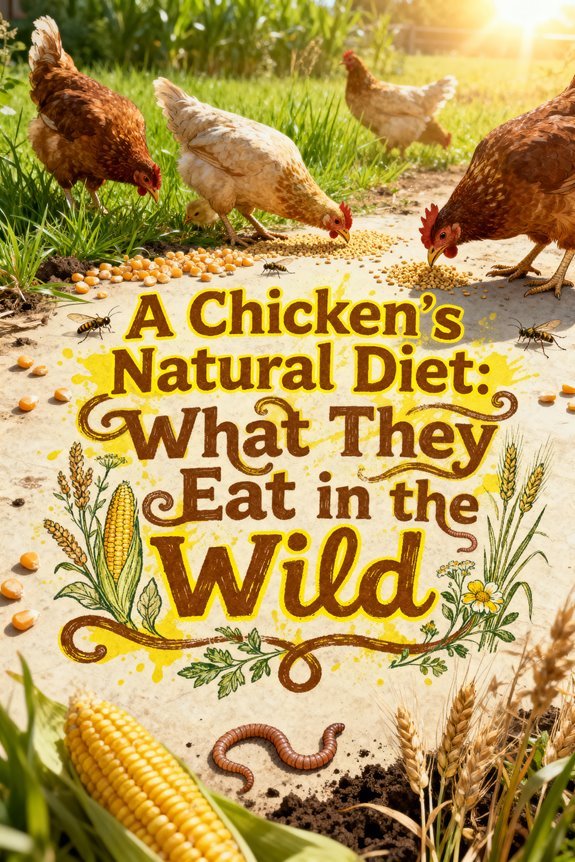A Chicken’s Natural Diet: What They Eat in the Wild
In the wild, you’ll find chickens actively foraging for a diverse menu that includes seeds, grains, insects, and small prey. They’ll scratch and peck at soil to reveal protein-rich food sources like black soldier fly larvae, mealworms, and crickets, which provide 21-80% crude protein. These omnivorous birds also consume tender shoots, wild greens, and snail shells for essential vitamins and minerals. Understanding their natural diet reveals fascinating insights about ideal chicken nutrition and behavior.
Wild Chickens and Their Foraging Habits
While wild chickens may appear to eat indiscriminately, they’re actually selective foragers with distinct dietary preferences. You’ll find them methodically picking through vegetation much like they’re selecting items from a salad, choosing specific leafy greens like clover, alfalfa, and dandelions. Chickens especially seek out high-protein food sources when hunting for small insects, worms, and even tiny reptiles. This natural hunting behavior helps control garden pest populations while providing essential nutrients for the chickens.
Their foraging strategies extend across diverse microhabitats, from dense vegetation to forest floors and grasslands. You’ll observe them scratching through leaf litter and plant debris, searching for seeds and grains that provide essential carbohydrates. Their habitat diversity is significant, as they rely on different environmental zones to meet their nutritional needs. This natural foraging behavior not only provides them with critical nutrients but also keeps them actively engaged, reducing harmful pecking behaviors and promoting their overall well-being. When chickens consume alfalfa in their natural habitat, they benefit from its rich vitamin content that supports healthy egg production and plumage development.
Natural Protein Sources From Insects and Small Prey
When it comes to protein sources, wild chickens actively seek out a diverse array of insects and small prey that provide necessary nutrients for their growth and health. The insect nutrition they obtain comes primarily from black soldier fly larvae, mealworms, crickets, grasshoppers, earthworms, and various species of ants and termites. This protein variety is essential, as different insects offer unique nutritional profiles, with crude protein content ranging from 21% to 80% by dry matter. This natural foraging behavior aligns perfectly with sustainable food waste reduction since insects like black soldier fly larvae help consume pre-consumer food waste. You’ll find these insects provide chickens with necessary amino acids like methionine, cystine, and lysine, which are crucial for their development. The natural foraging behavior of chickens targeting these protein sources also contributes to their gut health through beneficial antimicrobial compounds found in insect larvae, enhancing their immune function and overall well-being.
Plant-Based Foods in a Wild Chicken’s Diet
In addition to their insect-based protein sources, wild chickens derive substantial nutrition from diverse plant materials throughout their habitat. You’ll find them consuming various seed types, from grass seeds to bamboo, as these provide essential fatty acids and energy-dense carbohydrates. They actively forage for tender shoots, young leaves, and seasonal fruits, which deliver significant vitamins and minerals. Asparagus can provide them with essential amino acids and important antioxidants when found in their environment.
Plant diversity plays an important role in their diet, with chickens showing particular preference for specific wild greens like sheep sorrel, chickweed, and clover. Their consumption patterns shift with seasonal availability – they’ll increase seed foraging in late summer, focus on fresh greens in spring, and take advantage of fruits and berries when available. This natural rotation guarantees ideal nutrition and supports their digestive health year-round. Free-ranging chickens need plenty of space to roam safely to maintain these natural foraging behaviors and prevent destructive habits. Keeping their nesting areas at proper height levels of 18-20 inches helps protect gathered food from contamination while they rest.
Essential Minerals and Vitamins From Natural Sources
As wild chickens forage throughout their habitat, they obtain essential minerals and vitamins from diverse natural sources. They gather calcium from snail shells and limestone particles, while phosphorus comes from seeds and small vertebrates. Mineral absorption occurs naturally as they consume insects, which provide copper, zinc, and iron. They’ll find magnesium in leafy greens, and electrolytes like potassium and sodium in plant sap and soil particles. Unlike domesticated chickens that require commercial feed formulations, wild birds naturally balance their mineral intake through instinctive foraging behaviors. Similar to the Brown Leghorn breed, wild chickens are excellent foragers that thrive in free-range environments.
For vitamin sources, chickens rely on dark leafy plants for vitamins A and K, while vitamin D3 is synthesized through sunlight exposure. They get B vitamins from insects and organ meats, and although they produce vitamin C internally, they supplement it by consuming fruits and vegetables. The combination of foraging and synthesizing guarantees they maintain ideal nutritional balance. A well-balanced intake of vitamins through natural food sources is crucial for maintaining their immune system and reproduction.
The Benefits of Natural Foraging vs. Commercial Feed
Natural foraging and commercial feed each offer distinct advantages for chicken nutrition and welfare, though their impacts vary considerably. When you observe chickens’ dietary preferences during foraging, you’ll notice they actively seek insects, seeds, and plants, engaging in natural behaviors that promote physical and mental well-being. These feeding practices result in eggs with richer yolks and potentially higher omega-3 content. Many chickens will even forage for wild rose petals to obtain beneficial vitamins that support immune health. Just like their heritage breed counterparts, modern chickens retain strong foraging instincts that drive their natural curiosity and exploration.
Commercial feeds, while ensuring consistent nutrition, can’t fully replicate the diverse micronutrients found in foraged diets. You’ll find that foraging chickens display increased activity and reduced stress behaviors compared to those limited to commercial feed. However, it is crucial to understand that modern breeds, especially layers, can’t meet their full nutritional requirements through foraging alone. The ideal approach combines both feeding methods to optimize health and satisfaction. Modern commercial feeds contain carefully formulated protein and mineral sources that help maintain optimal chicken health.



